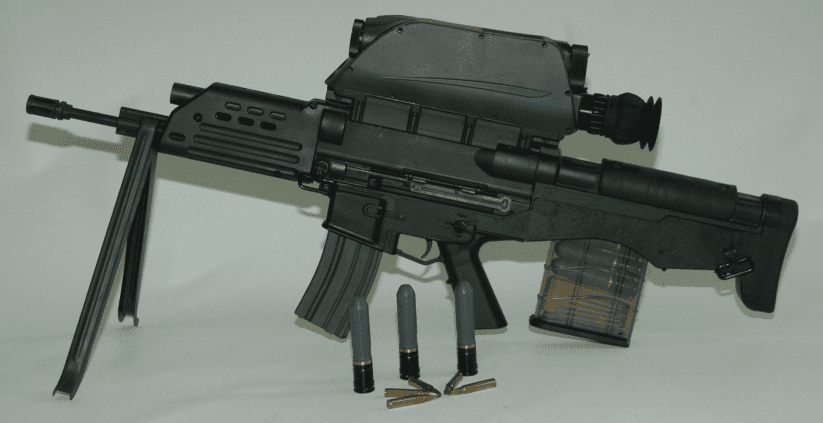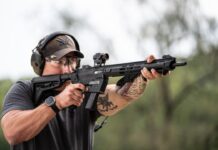“The S&T Daewoo K11 DAW (Dual-barrel Air-burst Weapon) [above] is an assault rifle chambered to fire 5.56×45mm NATO rounds, as well as 20×30mm air-burst smart grenade from its overbarrel launcher.” wikipedi.org informs, correctly deploying the “a” word. “Two conventional 20 mm shells either detonate immediately on impact or on a timed fuse after impact. A third type of shell is controlled by the weapon’s integrated electronics to explode a few meters from the target, yielding an air burst effect capable of killing targets within a 6m area and seriously wounding those within an 8 m area. Users enter a range at which the shell is to detonate, allowing targets in ditches, in buildings, or behind walls to be destroyed without requiring the shell to strike the target.” In theory. In practice . . .
South Korea will complete a major upgrade on the home-grown dual-barrel K-11 rifle by the end of 2016, the head of the state defense development agency said Wednesday, after the use of the Army assault rifle was suspended last year due to a glitch in the shooting control system.
“(We) are pushing to improve the K-11 dual-barrel rifle by a large scale before the end of next year in order to turn what has become an ugly duckling into a swan in the shortest time possible.” . . .
Since a major defect was found in the shooting control system in September last year, the production and use of the K-11 rifle have been suspended, including about 900 units that had already been distributed to the Army.
Even before last year, the assault rifle had defects in many other parts, including barrel movement during firing and the striking mechanism.
The agency has successfully developed the technology to reduce the shock generated in firing the 5.56 mm rounds by as much as 40 percent and it is also reviewing a design to decrease the shock of launching the 20 mm shells, Jung said.
The envisioned upgrade may cut back by 10 percent the weight of the K-11 rifle, now weighing 6.1 kilograms, he said.
The upgrade is also likely to strengthen the ammunition power of the rifle while modifying it to be better fitting for human use, he also said.
As the koreaherald.com report reports, the K-11 rifle is part of the country’s efforts to replace all their imported weapons with domestically-produced variants. As wikipedia.org points out, the U.S. version of the K-11 airburst rifle is not without its issues . . .
One of the problems with the previous American Objective Individual Combat Weapon, which influenced the combination rifle/airburst launcher concept, was that its 20 mm grenade rounds were not very lethal. The fragments were often too small and light to be effective, there was not enough explosive material to create a large kill radius, and many fragments were dispersed vertically and away from the target. This was one of the reasons the OICW effort was cancelled, and it is not known if these deficiencies were addressed with the K11’s airburst grenades of the same size.
Good on Korea for keeping with it. Haenguneul bileoyo with that.





I cant imagine taking this thing through a serious rifle training course let alone actually having to carry it around and use it in combat.
I imagine it would be a replacement for M249 or similar weapons.
I wouldn’t think an entire unit would have these.
The long-term goal with all these efforts is exactly that. Which makes sense, given that it defeats many types of cover commonly found on the battlefield, so if done right, it should significantly improve the lethality of your average infantry squad.
As much as I thought the OICW was a cool concept, by all reasonable accounts it appears that 20 MM just isn’t large enough (and also has too much recoil for practical implementation) – and it really just makes more sense to decouple the smart round launcher from the rifle and go with something larger for the smart grenade launcher as a separate weapon. But I guess they haven’t given up the ghost and come to that conclusion quite yet, as the US .mil has. One can only carry so much ammo. I feel bad for the poor grunt that would be expected to tote this thing around with any reasonable amount of ammo. I think it is much better suited for the realm of video games, where you can lug six weapons and thousands of rounds of ammo while jumping 12 feet in the air and running full speed non-stop.
Which is exactly what they did with the grenade system of the XM29, which is now the XM25, aka “The Punisher”, a nickname given it by the soldiers fielding test units in Afghanistan in 2010-2013. They *loved* it. Many of the soldiers carrying the XM25 wouldn’t carry an M4 as a backup, they were that confident in them. Designed by H&K, Alliant and L3.
A misfire with a KB that slightly injured the shooter at Aberdeen caused them to pull the units from the sandbox, and they were moved from full production to low rate production status. They should be fielding the redesigned units late this year.
It’d almost serve the same role as a mortar team, wouldn’t it?
Better than a mortar, because you can put rounds through a window, and have them go off just after they’ve gone past the window. Your mortar isn’t as a accurate, and in this case, would be hitting the roof in any event.
But I think the army was right, the combined gun is too heavy. And 19 or 20mm is too small for the rounds.
Even with the problems I’ll still gladly accept any of their free leftovers and a few cases of 20mm.
+
Just happy people are still working on the “rock”.
6.1 kilograms is 13.4lbs in real money. I’d rather carry a SAW.
While I am NOT usually a huge proponent of all run-of-the-mill infantry carrying a 7.62 of any type (SAW gunner, yes; DSM, sometimes; sniper, yes, if not a .338 or .50, but not basic infantry), if it weighs more than a 7.62, and kicks like a 7.62 (hoping to reduce the 5.56 kick by 40%?), why not just go with a lighter 7.62 rifle, and let the ammo make up the weight difference so it’s now as heavy as their 5.56. It’s bizarro world in SoKor, apparently.
No kind of bullet can do what an air-detonated grenade can.
I could carry around 3 to 4 dozen mini revolvers, and not have that much weight. Strap ’em on up and down both legs!
Holy parallax, Batman!
And how is this better than a standard assault thingy with a 40 mil mil launchy pump goer up?
It uses a rangefinder to determine distance to target, and make the grenade explode above target in mid-air, showering it with fragments. Lobbing a regular 40mm grenade into an enemy trench at 100 yards is a very tricky shot, but with this thing, it’s ridiculously easy. In effect, it makes a lot of common types of cover readily obsolete.
I don’t get how these various science fiction guns are still draining the resources of various nation’s taxpayers. In this age of drones, air power, and unprecedented advances in guided ordnance, why the hell do countries still try to make saturday morning cartoons out of their infantry.
Because engineers are constantly working on problem to questions nobody asked but receive government funding.
Because you still need infantry to actually hold the ground. Drones, ultra-precise artillery and all that stuff is very nice, but they’re not a substitute.
20mm exploding shells are only effective when you are firing lots of them. One at a time, they are weak sauce. The US was smart to dump OICW, because a low-velocity 40mm grenade launcher (which we’ve had versions of since at least Vietnam) is way more practical to man-carry and way more lethal. See, for example, the old M203 (“say hello to my little friend”) and the new M320.
I fired both 20MM, and 40MM when I was in Korea, yes the definitely IS a difference!
I thought this thing had died back when I was a teenager back in like 2002 and was only adopted by the U.S. Military in games like Ghost Recon (ah the nostalgia…)
The XM25 was awesome in Ghost Recon 2. Not so much IRL.
I remember it being like the ultimate weapon in Soldier of Fortune II, never quite figured out how to use it though. I always preferred the M4/M203.
While the soldier is entering the distance, wind direction, and requesting a ROE exception via wifi, the barbarian has run up and hacked him to death with a machete.
Lmfao but that’s exactly what I picture when I think of this stuff! Nice play on words with “hacked” lol not sure if that was unintentional but it worked nicely.
I cannot imagine trying to use this thing in combat and trying to enter all the information on a fast moving battlefield.
If you can’t even handle that much, maybe you shouldn’t own any kind of gun.
I remember during the first Iraq war they were retrofitting dumb bombs with electronics to turn them into smart bombs. Couldn’t anyone figure out how to do that with a m203 instead of this or OICW?
The great thing about retrofitting the old iron gravity bombs is that the bomb remains the same, you just add moving fins and a guidance package to the outside of the casing. In some cases, part of the guidance package is outside the projectile, like with a laser designator.
When you have to fit any kind of electronics, whether for guidance or for fusing, inside a projectile, you start quickly running out of room for the actual explosive payload or propellant. This for both weight and volume, and when you start talking about really small projectiles like the 40mm grenade, there’s not much room to start with.
To make it worse, for a projectile, the electronics have to be tough enough to withstand the acceleration forces from launch. No such problems with a bomb, as long as it functions until the moment of impact.
Civilian version coming to shot show 2020??
Well it LOOKS cool. Maybe it’ll show up in the next Tom Cruise movie or Captain America 3…
Whenever I hear of the k11 I see an EAA Witness ad in my mind…
A better idea: fire 40 mm grenade. If that doesn’t kill the target, fire another 40 mm grenade. Boom! Done.
I’m guessing “military style “weapons are fairly tightly controlled amongst civilians in South Korea. Enough so that ivory tower “weapons designers” don’t pick up on the fact that 13.4 lbs and assault rifle used in the same sentence is just a bit dissonant….
That is one goofy p.o.s. rifle lol. If it’s gonna have all that, it might as well be belt fed and on a tripod because nobody on the move is going to want that thing.
According to Wiki there was $69million budgeted for 1,400 X25 systems. That’s over $49,000 each. Unless someone is confused and that figure includes quite a bit of ammo that’s insane.
It’s not really insane for a prototype of a radical new weapon system. Most of that money isn’t manufacturing costs, it’s R&D. I would imagine that squeezing all the necessary electronics into a 20mm grenade is quite an engineering challenge, for example.
Who gives a shit……
Comments are closed.